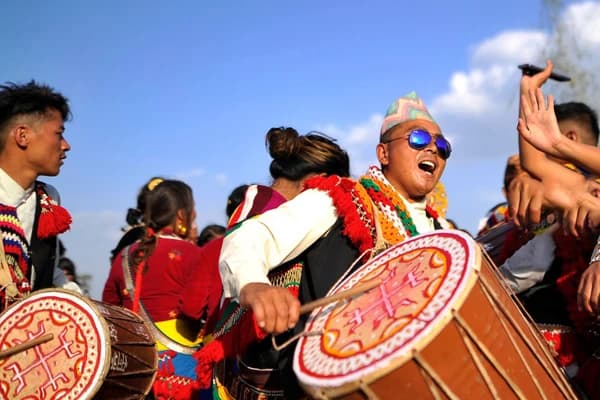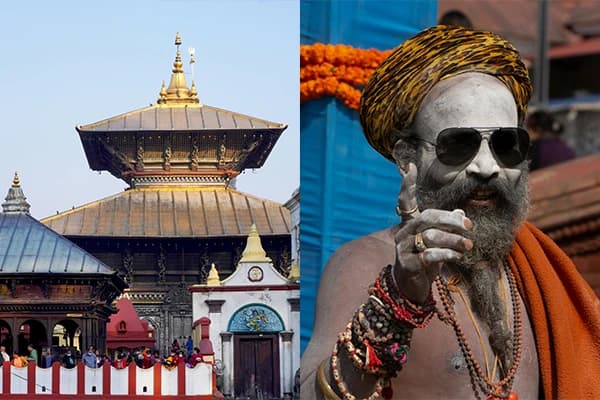Everest Base Camp Monsoon Trek Itinerary 2026
This is a possible itinerary that Mystic Adventure Holiday offers during the monsoon season. The unpredictable weather conditions may cause some changes in the planned journey.
- Day 1: Fly from Kathmandu to Lukla and trek to Phakding.
- Day 2: Hike from Phakding to namche bazaar.
- Day 3: Acclimatization Day in Namche Bazaar.
- Day 4: Trek to Tengboche village.
- Day 5: Hike from Tengboche village to Dingboche village.
- Day 6: Acclimatization Day in Dingboche Village.
- Day 7: Trek from Dingboche to Lobuche.
- Day 8: Trek from Lobuche to Gorak Shep, then to Mt. Everest Base Camp, then return back to Gorak Shep.
- Day 9: Hike from Gorak Shep to Kalapathar and trek to Pheriche.
- Day 10: Trek from Pheriche to Namche Bazaar.
- Day 11: Trek from Namche Bazaar to Lukla.
- Day 12: Fly from Lukla to Kathmandu.
Weather Challenges of Monsoon
In monsoon season, there is a frequent change in the weather in the Everest region, especially around the Mount Everest Base Camp area. The temperatures are chilly in the morning and at night. The day will be warmer even though it is raining.
In the lower elevations, the daytime temperature ranges from approximately 15°C to 25°C. The nights are always chilly. The nighttime temperature ranges from approximately 8°C to 15°C. The month of September is chillier than the other monsoon months, where it can go below 8°C even in the lower elevations.
While in the higher elevations, the daytime temperature ranges from around 0°C to 15°C. The nights are more chilly as compared to the lower elevations. In the places above the lobocue, the temperature goes below freezing and up to -5°C.
The heavy rain and rain clouds would stop you from enjoying the scenic beauty of the highest peaks like Annapurna, Ganesh Himal, Cho Oyu, Mt. Makalu, Mt. Lhotse, and many more.
If you are lucky, then you can see the clear skies and mountains after the rainfall, which is a once-in-a-lifetime opportunity. The lush valley, green hills, and gorgeous Himalayas are vividly seen due to rain clouds. If you are up for an EBC monsoon trek, we suggest you wear clothes in a layered manner to adjust yourself to the fluctuating weather conditions.
It may rain suddenly, so bring and wear waterproof clothes as the outer layer. The days in the lower Everest region, like Lukla, Phakding, and Namche Bazaar, will experience heavy rainfall, while there is light rain in the upper region.
In the mid-monsoon, you will experience gradual and heavy rainfall, starting late afternoon and night. It makes you see a clear and sunny morning.
Lukla Flight Conditions during Monsoon
Due to heavy rainfall, cloudy weather, and poor visibility, the flight service gets delayed or even cancelled. The Tenzing Hillary Airport, which is popularly known as lukla airport, operates the only flight services. Those going for the Mt everest base camp trek and the Gokyo Lakes trekcan use this airport service for transportation to Lukla from Kathmandu or vice versa.
When your flight gets delayed for more than an hour, you can simply take a walk around the airport. You can enjoy the natural beauty by taking a sip of a warm cup of coffee in the nearby cafe and hotel.
Trekking Trail in Monsoon Season
The trekking trail of the Everest Base Camp is very muddy and slippery, which makes it difficult for hikers to navigate in the rainy season. You should be very careful while walking to prevent any injuries or accidents. The frequent rainfall during the season makes it difficult to walk on the steep ascending and descending routes. So, make sure to bring proper rain gear along with waterproof trekking boots or gaiters.
When hiking at a high altitude, there are chances of natural disasters like landslides, erosion, and floods. So, prepare yourself mentally to deal with these calamities if occur. There are few places in the Everest Base Camp trail where landslide and soil erosion may occur. Besides this, bugs, leeches, mosquitoes, and many other parasites add difficulty during the hike.
These creatures are more active in monsoon season, so properly cover your arms and legs with windproof clothing. You need to bring insect repellent spray while trekking in the monsoon season.
The Everest Base Camp trail passes along many wild forest and woodland areas, which are the main habitat of insects and bugs. During monsoons, the damp area favors the growth and multiplication of insects and bugs, making you more susceptible to their attacks and bites.
You can see more diverse insects and bugs, along with other wild creatures, while passing through Sagarmatha National Park. Lastly, you need to frequently check your body to see if any parasites or insects bite you to stop excessive bleeding.
Scenic Attractions on the Trail
The benefit of a Mount Everest base camp hike in monsoon season is a picturesque view of natural beauty. The rainfall provides the plants and vegetation with a new life, and they transform into beautiful greenery, which gives energy to the freshly formed green landscape.
You can get a breathtaking view of majestic mountains, glaciers, fresh green forests, and woodland. The different types of wildflowers flourish and bloom during the rainy season.

You can pass through different flora and fauna, like sheep and deer, in the Sagarmatha National Park. This natural beauty will remove all the hardship you experienced during the hike. If you are interested in photography, then it is the perfect time to capture pictures of your surroundings. You will experience heaven when walking above the freshly formed clouds after rainfall.
This adds beauty to the sunset, as you can see a golden sun hiding behind the clouds. If you are interested in stargazing, the clear sky after rainfall will provide you the opportunity to experience it.
Food & Accommodation
The easy management of food and accommodation is the perk of Mount Everest trekking in the monsoon season. Despite the size and number of the group, managing food and accommodation is quite handy.
Even though it is off-season, the tea houses and lodges are open for service in the higher region because they are run by the families of local people. So, you will enjoy the same facility of hospitality in the rainy season as well.
You will enjoy eating in a less crowded dining hall. The less competition for food, the more it would let you eat food of your preferences. You can also ask for extra seasonal dishes on the menu or may get a bonus side dish from the hotel. It is not necessary to book a hotel in advance because, due to fewer crowds, most of the hotels are available.
You can also ask for a single room with an extra charge, along with internet and a hot shower facility. If you are uncomfortable sharing the communal bathroom, you can also ask for rooms with an attached bathroom. The hotel and lodges offer communal bathrooms built in the squats.
During your trip, all the tea houses and lodges provide lunch and dinner of your choice on the menu, like Dal Bhat, Curry, Gundruk, Aloo Tama, Shyaphale, Thukpa, Dhindo, Soup, Steak, and so on.
You can eat a variety of international dishes like fries, burgers, sandwiches, pizza, momo, chow mein, noodles, etc. All the food items are freshly made and served warm. They will serve Tibetan bread, chapati, tsampa porridge, tingmo, buckwheat bread, sel roti, pancakes, muesli, eggs, toast, butter, jam, honey, oats, cornflakes, and many other items for breakfast.
Packing list for Monsoon season
The Mount Everest base camp A monsoon trip is quite peaceful and challenging. The monsoon season brings moderate to heavy rainfall, depending upon the weather conditions. So, you have to pack appropriate gear. The lower region is quite muddy and slippery, so bring good footwear.
Make sure to pack everything without overloading your luggage. We, Mystic Adventure Holiday, will provide a helpful porter to assist with your baggage, and your baggage must weigh at least 15 kg.
Here is a list of things you need to pack in your baggage for trekking in the monsoon season on the Everest Base Camp trekking trails:
A. For head and body
- Sun-brim hat
- Lightweight beanie and insulated hat
- Headscarf and neck scarf
- T-shirt (different layers)
- Lightweight cotton shirt and thermal vest
- Sweater or sweatshirt and fleece jacket
- Waterproof/windproof hooded jacket and insulated jacket
- Down jacket for alpine zones
- Waterproof hiking shorts and waterproof trousers
- Lightweight cotton pants and insulated warm trousers
- Comfortable innerwear
B. For Feet
- Lightweight sock and warm insulated sock
- Trekking boot with good traction and grip
- Sports shoes with good traction
- Sandals or Crocs with good grip and waterproof gaiters
C. Personal Hygiene/Toiletries
- Toothbrush, toothpaste, and floss
- Biodegradable soap and shampoo
- Sunblock cream, lip care, and moisturizer
- Face wash or cleanser and a small mirror
- Nail clipper and shaving razor
- Travel towels, tissue paper, and wet wipes
- Toilet paper, handwash, or sanitizer
- Insect repellent deodorant or cologne
- Foot powder and female hygiene products
- Personal medication
D. Trekking Equipment
- Trekking pole and sunglasses (UV protection)
- Sleeping bag and backpack with rain cover
- Duffle bag, rain cover for luggage, and raincoat
- Headlamp and water filtration system
- Water bottle and thermos flask map,
- Compass and GPS multi-tool knife
- Power bank, repair kit, and packing sack
- Binoculars and cameras
- Guidebook and first-aid kit
Training and Preparations
The Everest Base Camp trekking in the monsoon season is challenging, and your training and preparation depend on the success rate of your journey.
The monsoon season brings many challenges along with heavy rainfall like soil erosion, landslides, parasite attacks, and floods. So, you need to be mentally and physically prepared to tackle all sorts of challenges during the hike. You need to start your training 3 to 6 weeks before your actual hike.
You should stay consistent during the training and focus most of the time on strength and endurance. When you are hiking at a high altitude, cardiovascular and stamina training will boost your immunity power for long hours.
Make sure to practice walking uphill and downhill, followed by hiking in nearby hills. Moreover, this practice hike will help your body become familiar with the upcoming real hike. This will be a bonus for you and will make your hike a success.
Permits and Passes Requirements
The Everest Base Camp monsoon trek requires two permits: the Khumbu Pasang Lhamu Rural Municipality Entry Permit and the Sagarmatha National Park Entry Permit.
You can obtain the Sagarmatha National Park permit in Kathmandu or at the entry gate in Monjo. The cost of the Sagarmāthā National Park entry permit is around NPR 3,000 (approx. USD $25) for foreign trekkers and NPR 1,500 for SAARC nationals.
The Khumbu Pasang Lhamu Rural Municipality entry permit can be obtained in Lukla or Monjo. The cost of this permit is NPR 2,000 for the first month.
If you are traveling via the Jiri side, you need to have another optional permit, the Gaurishankhar Conservation Area Permit. It costs USD 23, which is around NPR 3000, and you can only acquire it if you hire an experienced guide. You can’t hike alone in the Everest region without a professional guide.
Tips for Everest Base Camp Monsoon Trek 2026
- Make bookings for the hotels in advance.
- Don’t forget to pack the necessary rain gear, a waterproof layer, and an umbrella.
- Observe your body's symptoms related to altitude sickness.
- Follow the instructions of the guide and be respectful.
- Walk without rushing and be cautious with your footing.
- Stay hydrated by consuming a balanced diet.
- Avoid any kind of intoxication, like alcohol, cigarettes, and so on.
- Share your issues with your guide and be flexible.
- Value local culture, tradition, and norms.
- Pack your baggage smartly, avoiding unnecessary items.
Do’s & Don'ts During Your Trip
There are many monasteries and Gompas in the Everest region. So, you need to have a dress code while visiting these cultural and religious heritages. You need to dress modestly and avoid wearing too revealing clothes inside the premises of monasteries and gompas.
Secondly, you need to be respectful towards the local culture, customs, and tradition. Make sure to take off your shoes or slippers while entering the temple or monastery while respecting the monks.
Lastly, you need to ask permission to take photographs of people and places. You need to get consent from the authorities of the temple or monastery to make videos and capture photos.
As we know, most of the trekkers are from foreign countries, so make sure to learn about the cultural importance of people living in the Himalayas beforehand. Avoid wearing short clothes that are too revealing, as it shows disrespect to the existing culture when you are inside the premises of a temple or monastery.
Be respectful towards monks and do not touch them, as they have vowed to never touch any women in their lives. Do not visit religious places under the influence of drugs or alcohol.
During your trip, be careful of your actions, as they may affect other people's privacy. When you are taking pictures, ask for other people's consent, whether they want to be in the photo or not. Do not mess up their privacy by clicking pictures with them.
You are trekking in a peaceful environment filled with the natural and cultural richness of the Everest region, so enjoy it fully without doing any harm to wildlife or vegetation.
Avoid any kind of intoxication, like drugs, alcohol, or smoking, while trekking. This may result in your health disturbances and lead you to suffer from extreme altitude sickness.
Do not light a fire in the jungle, and do not kill birds, flora, and fauna of the area. Make sure to hike peacefully without disturbing the wildlife or the natural ecosystem of the area.
To sum up..
The Everest Base Camp monsoon trek brings numerous challenges and adventures along with the private trekking experiences and lush green atmosphere. Besides this, you get the opportunity to observe the unique biodiversity in the rainy atmosphere.
Ready to Hit the Trail? Book Your guided trek Today!






